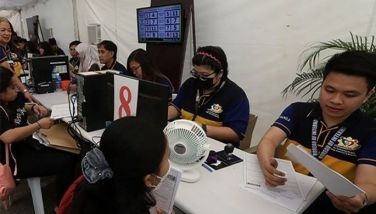To dredge or not to dredge

Floods are part of a Pinoy’s life. I remember annual floods where I grew up in Paco, Manila, so that our refrigerator is on the second floor. Not convenient because the kitchen and dining are on the first floor, but necessary because of the floods.
As a journalist, I have heard people, who understand science and our politics, cynically say that the flooding problem will never be solved because it enriches our politicians. The flood control budgets of the DPWH and other agencies, including LGUs, provide a constant source of funds that line the pockets of officials and their friendly contractor friends.
Producing studies to deal with our floods is also a staple for researchers working for ODA agencies like JICA and the World Bank. Indeed, I think flooding has been over studied. We know what to do, but we are not doing what we should.
The big debate through the decades is to dredge or not to dredge – and the debate is far from over.
Experts have made a living making it seem like they are looking for a solution to our flooding problem. I have a more simplistic view.
First of all, I think we ought to do something about our denuded mountains. Unless we reforest those bald mountains in Montalban and the foothills of Sierra Madre, nothing we do by way of engineering solutions in the metro areas below will work.
The topsoil of the mountains will continue to be eroded and be carried by the flow of water during the rainy season to cause siltation and worsen flooding below. We need trees to hold on to the water and prevent flash floods.
Second, we need to dredge to provide immediate relief. It will not solve the problem long term, but like aspirin, it will alleviate the headache. We need to dredge the rivers and the Laguna Lake. It seems obvious even if the experts are still debating that.
Laguna Lake, which takes in Sierra Madre floodwaters, is now only two meters deep from 22 meters some years ago. Look at it as a bathtub with 23 faucets and the Pasig river is the only exit drain. The dredging can help even if it is not the ultimate solution.
There was a last-minute award by the Arroyo administration for a Laguna Lake dredging project to a Belgian company. PNoy stopped the project saying it was awarded in haste without scientific studies. Corruption was implied but that’s always the case with projects of such nature.
The Belgian company took our government to arbitration and won. The International Center for the Settlement of Investment Disputes (ICSID) issued the award in favor of the Belgian company on Jan. 23, 2017.
The deal was junked six years earlier even if it was twice declared by then-Justice secretary Leila M. de Lima as “legal and binding”. Our government is obligated to pay P800 million in damages for the scrapped Laguna Lake project.
Maybe the final bill for the taxpayers is over P1 billion, including legal fees and other costs.
Former DPWH secretary Babes Singson explained that “what was cancelled was a corrupted dredging project in Laguna Lake which would also create a navigational lane.
“But what we did was properly implement a plan to dredge systematically starting from the mouth of the Pasig River and create an increased embankment on both sides of the Pasig River going to the Marikina River. If we did not clear the river embankments of the squatters, more people would have perished.
“What they need to implement is the full flood control master plan for Metro Manila. Key component is a regulating dam upstream in Montalban/Rodriguez. This way water from the Sierra Madre Mountains will come down the Marikina River based on its carrying capacity.”
Carlos A. Arcilla, a professor at the UP National Institute of Geological Sciences, thinks PNoy was justified in canceling the P19-billion Laguna de Bay dredging contract. Arcilla wrote that it was technically flawed and would not have controlled flooding in the metropolis.
Arcilla wrote in the Inquirer: “My testimony at the Philippine Republic vs Baggerwerken trial in Washington (international arbitration case in the World Bank, 2014) regarding the fraudulent P8-billion Pasig dredging project and the proposed P18-billion Laguna de Bay dredging project showed that very little technical vetting was done.
“We discovered that the Laguna de Bay and Pasig dredging projects were not properly vetted technically even if these were endorsed by the DPWH, Department of Environment and Natural Resources and, especially by the National Economic and Development Authority (NEDA). The Philippine position was weakened because the lack of vetting was probably intentionally done to promote corruption.”
Arcilla is also negative about the Montalban Dam. He wrote: “The bulk of this flood control program, a P200-billion dam in the Montalban area, may not be able to accommodate upstream river excess discharge.
“Thus, any comprehensive flood control plan in this area must include a way to reduce extreme rainfall-related river discharge flowing into the Marikina River, which is the greatest source of discharge into the Laguna de Bay.”
Arcilla also warned that “flood control plans that will involve large dams in the Montalban watershed should also consider the existence of active faults in the area and the very large watershed areas that will be flooded to accommodate the dam water.”
It is interesting that Arcilla also criticized a P350-billion Metro Manila Flood Control Plan that was approved by the NEDA.
“Despite the best intentions, NEDA does not have the wherewithal to do thorough technical vetting, especially for large-ticket projects.
“We should end this rapacious cycle of creating substandard projects to be funded by sovereign loans from foreign banks that bring their own consultants who will not be looking out for genuine Philippine interests.
“There are enough competent Filipino engineers and scientists who are honest and patriotic. They should help vet these projects and help stop this great corrupt leakage of funds…”
More on this never-ending debate in a future column. Suffice it to ask: What do we do now? This debate can’t go on much longer. We are already drowning in words, studies and floodwater.
Boo Chanco’s e-mail address is [email protected]. Follow him on Twitter @boochanco
- Latest
- Trending

























